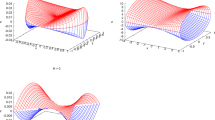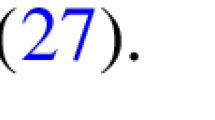Abstract
This paper concerns transitions of a mechanical system, in a given time, from one state, in which the generalized coordinates and velocities are given, into another one, in which the system should have the required coordinates and velocities. It is assumed that such a transition may be effected using a single control force. It is shown that if one determines the force using the Pontryagin maximum principle (from the minimality condition of the time integral of the force squared during the time of motion), then a nonholonomic high-order constraint occurs in the defined process of motion of the system. As a result, this problem can be attacked by the theory of motion of nonholonomic systems with high-order constraints. According to this theory, in the set of different motions with a constraint of the same order, the optimal motion is the one for which the generalized Gauss principle is fulfilled. Thus, a control force that is chosen from the set of forces that provide the transition of a mechanical system from one state to another during a given time can be specified both on the basis of the Pontryagin maximum principle and on the basis of the generalized Gauss principle. Particular attention is paid to the comparison of the results that are obtained by these two principles. This is illustrated using the example of a horizontal motion of a pendula cart system to which a required force is applied. To obtain the control force without jumps at the beginning and the end of the motion, an extended boundary problem is formulated in which not only the coordinates and velocities are given at these times, but also the derivatives of the coordinates with respect to time up to the order n ≥ 2. This extended boundary-value problem cannot be solved via the Pontryagin maximum principle, because in this case the number of arbitrary constants will be smaller than the total number of the boundary-value conditions. At the same time, the generalized Gauss principle is capable of solving the problem, because in this case it is only required to increase the order of the principle to a value that agrees with the number of given boundary-value conditions. The results of numerical calculations are presented.
Similar content being viewed by others
References
F. L. Chernous’ko, L. D. Akulenko, and B. N. Sokolov, Control of Oscillations (Nauka, Moscow, 1980) [in Russian].
L. S. Pontryagin, V. G. Boltyanskii, R. V Gamkrelidze, and E. F. Mishchenko, Mathematical Theory of Optimal Processes (Nauka, Moscow, 1983; Interscience, 1962).
Sh. Kh. Soltakhanov, M. P. Yushkov, and S. A. Zegzhda, Mechanics of Non-Holonomic Systems. A New Class of Control Systems (Springer-Verlag, Berlin Heidelberg, 2009).
N. N. Polyakhov, S. A. Zegzhda, and M. P. Yushkov, Dokl. Akad. Nauk 269(6), 1328–1330 (1983).
D. N. Gavrilov and S. A. Zegzhda, Vestn. St. Peterb. Univ., No. 3, 77–83 (2012).
S. A. Zegzhda, P. E. Tovstik, and M. P. Yushkov, “The Hamilton-Ostrogradski generalized principle and its application for damping of oscillations,” Doklady Physics 57(11), 447–450 (2012).
Author information
Authors and Affiliations
Corresponding author
Additional information
Original Russian Text © M.P. Yushkov, S.A. Zegzhda, Sh.Kh. Soltakhanov, A.A. Pashkina, 2014, published in Vestnik Sankt-Peterburgskogo Universiteta. Seriya 1. Matematika, Mekhanika, Astronomiya, 2014, No. 4, pp. 55–64.
About this article
Cite this article
Yushkov, M.P., Zegzhda, S.A., Soltakhanov, S.K. et al. On the relationship between control theory and nonholonomic mechanics. Vestnik St.Petersb. Univ.Math. 47, 181–188 (2014). https://doi.org/10.3103/S1063454114040086
Received:
Published:
Issue Date:
DOI: https://doi.org/10.3103/S1063454114040086




